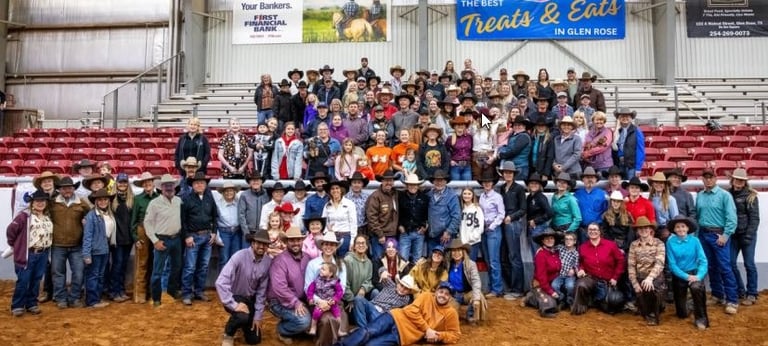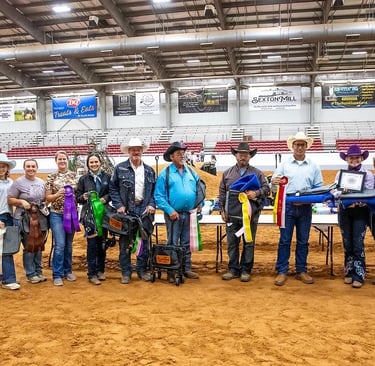EXCA World Finals
Diving into Extreme Cowboy racing: My world Finals Adventure
11/2/2025
A Leap into the Unknown
I never imagined I’d find myself charging through an obstacle course on horseback at breakneck speed, but that’s exactly where I ended up the week of October 27–November 1. My horse Rocky and I packed up and ventured to the Extreme Cowboy Association (EXCA) World Finals in Glen Rose, Texas – ready (or so we thought) to test our riding skills in a whole new arena. I had only been introduced to Extreme Cowboy Racing earlier this year, and after just three local shows under my belt, here we were at the World Finals. Little did I know what we were in for. The atmosphere in Glen Rose was electric: twelve divisions of riders from kids to seasoned pros, all converging to compete and cheer each other on. I could feel my heart pounding as we walked into the arena for our first run, not knowing if Rocky and I were truly prepared for this fast-and-furious challenge. But one thing was certain – we were about to have one of the most exciting experiences of our lives.

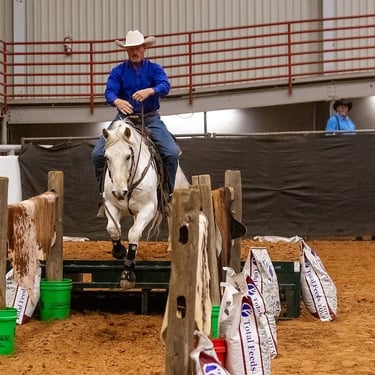
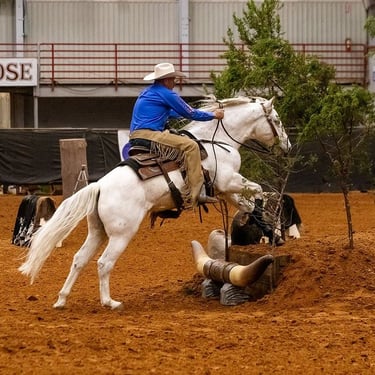
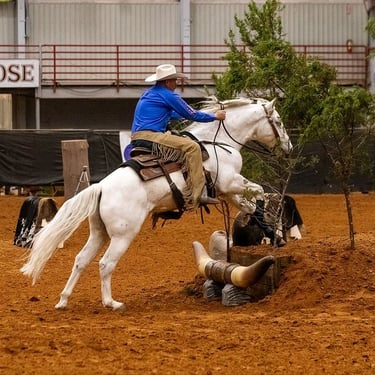
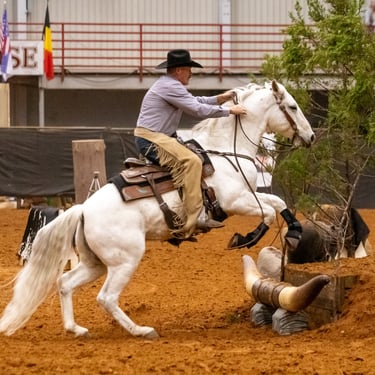

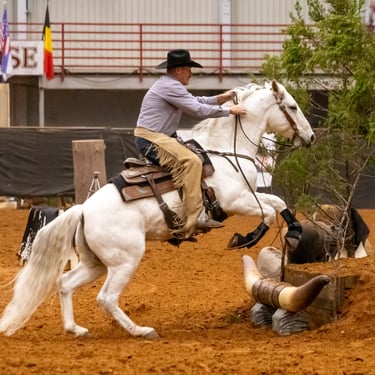




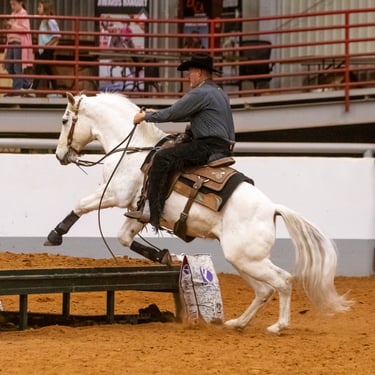
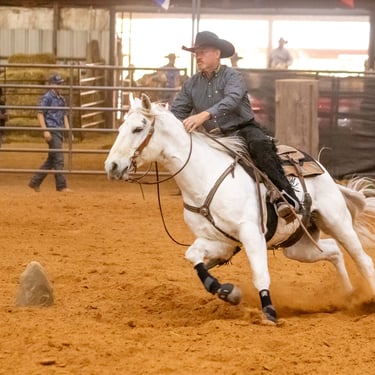

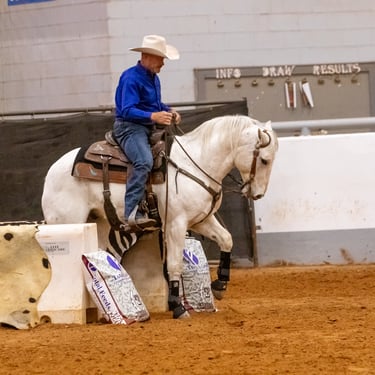
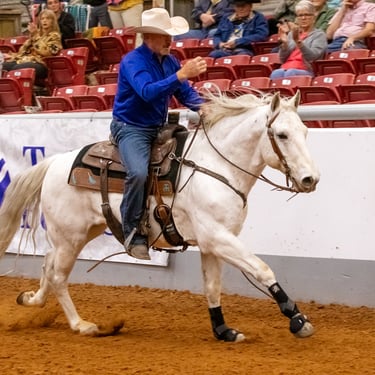
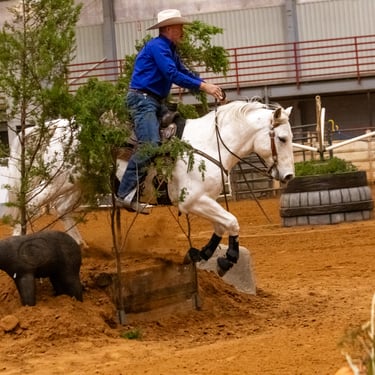


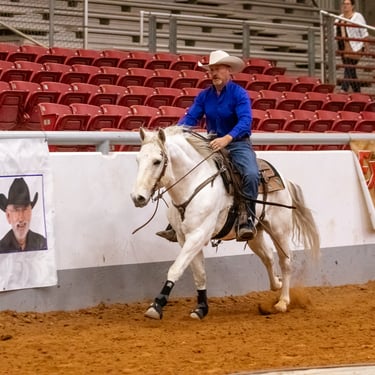
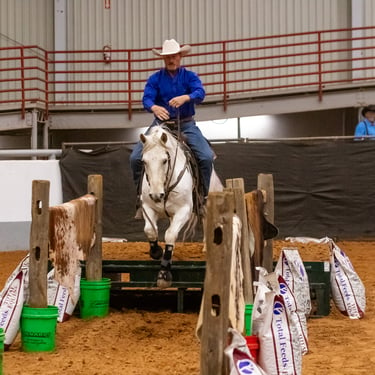
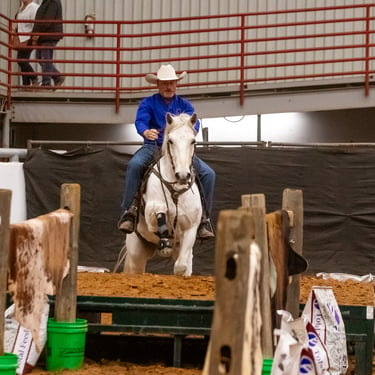
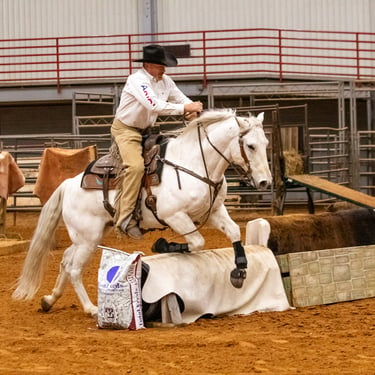
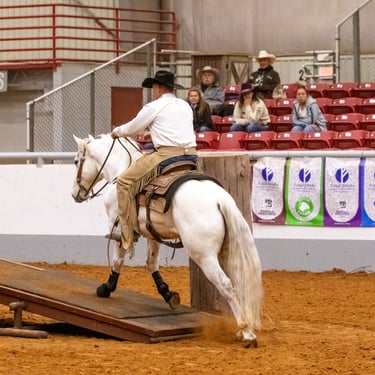
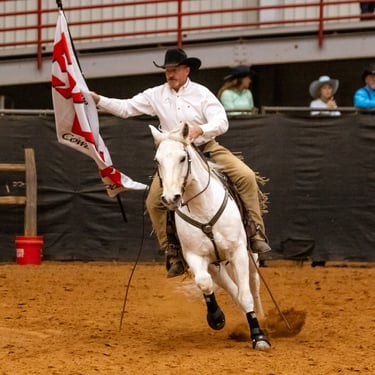
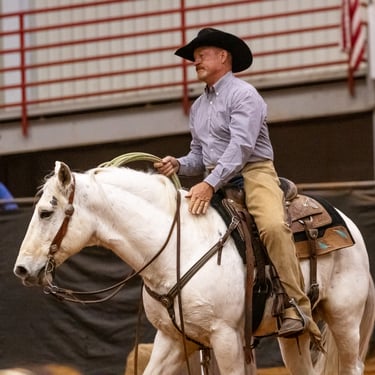

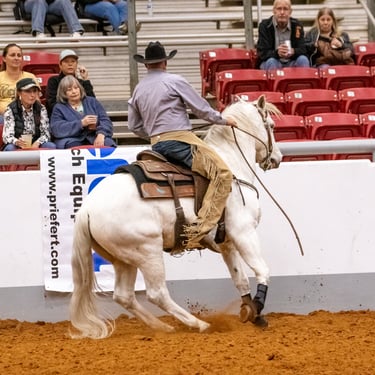
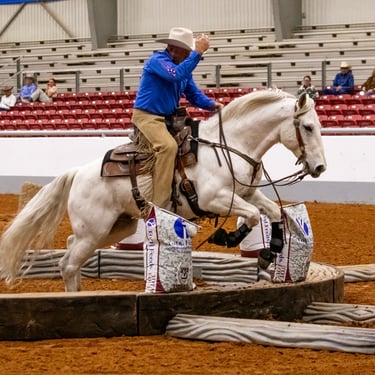
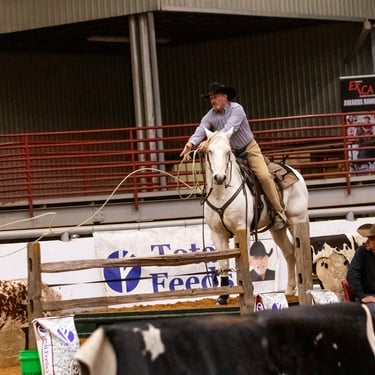


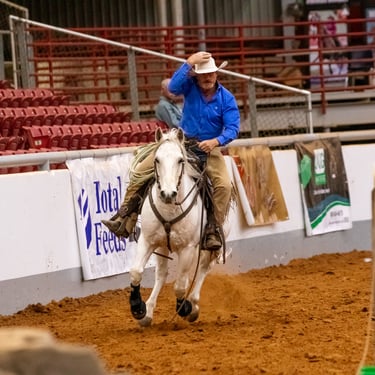

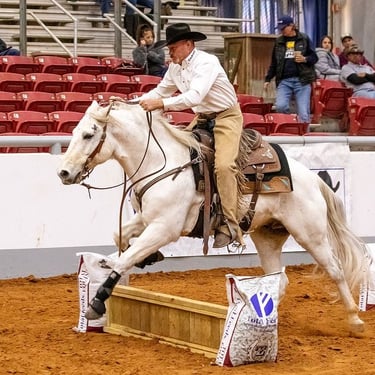
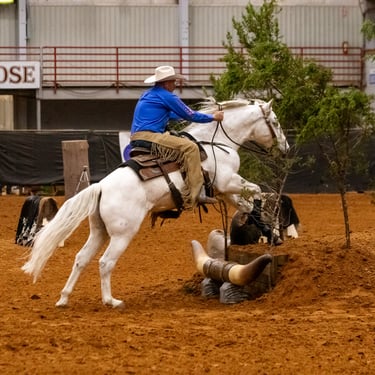
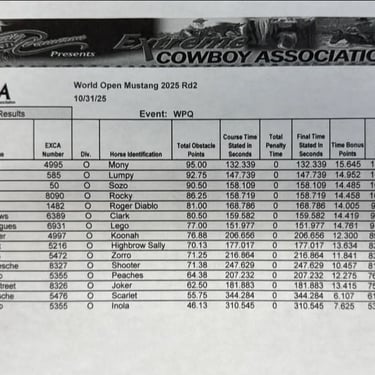
Extreme Cowboy Racing is a relatively new sport designed to test the versatility, speed, and trust between horse and rider. Created by famed horseman Craig Cameron in the mid-2000s, EXCA competitions are essentially timed trail courses amped up to an extreme. Unlike a typical arena trail class, these courses feature obstacles and tasks far beyond the usual trot over poles or open a gate. The goal is to push horse and rider out of their comfort zones and showcase real-world horsemanship skills under pressure. Races can be held outdoors making use of natural terrain, or indoors with man-made challenges, but either way they’re all about going fast while executing a wide variety of maneuvers with finesse.
One of the coolest things about EXCA is that anyone can participate. There are divisions for all ages and skill levels. At the World Finals I saw tiny “Young Guns” (kids 7–11 years old) guiding their ponies through the same obstacles that Non-Pros and even the Professional division riders tackled. There was even a “Ride Smart” division for riders age 55 and up, plus categories for Novice, Intermediate, Mustangs, Mules, Futurity and Green Horse for those of us just starting out. In total, about a dozen divisions ensured that every rider competed against others of similar experience. That said, the level of horsemanship on display across all divisions was incredible. Everyone—from first-timers to seasoned cowboys—shared the arena with a common passion, and the camaraderie was palpable. I quickly learned that EXCA isn’t just about competition; it’s a community. Folks were happy to help each other, walking the course together beforehand and even calling out tips or the next obstacle to competitors while they rode. This supportive vibe gave me a lot more confidence as a newcomer about to ride in my first World Finals.
The Obstacles: Not Your Average Trail Course
If you’re wondering what kinds of challenges an Extreme Cowboy Race throws at you, the answer is: pretty much everything but the kitchen sink. Each course typically contains around 13 obstacles or tasks to complete, and they can replicate anything you might encounter on a ranch – and then some. In one run, Rocky and I found ourselves scrambling up a mogul, trotting over a set of raised plateform, and then threading through a clump of trees and brush that had been dragged into the arena. Next, we had to cross a 5' skinny bridge and push through a flapping “cowboy curtain”. And that was all before we even got to the really exciting stuff! To give you an idea, here are just a few obstacles we either faced firsthand or watched other racers conquer:
Teeter-Totter Bridge: Guiding your horse up onto a narrow bridge that tips like a seesaw. It takes trust and balance to keep moving as the bridge teeters under your horse’s weight, but it’s an amazing feeling once you get across.
Gate Work: Halting from a run to open and close a gate.
Drag or Carry Objects: Grabbing a rope to drag a heavy log behind the horse, or picking up odd objects and transfer them from one place to the next.
Freestyle Tricks: The craziest tasks test your boldness. We had to do a double ride, where we ran to a barrel and picked up another person who had to ride on the back of our saddle and we had to run around a rock and then drop the person back off. There’s never a dull moment.
Those are just a sampling – EXCA course designers seem to have endless creativity. Other common obstacles include backing your horse through a zig-zag pattern of poles, side-passing over logs, jumping over bales or barrels, carrying flags, pretty much anything you could think of. The mix of tasks keeps you and your horse on your toes the whole time. I remember looking at the arena before my run, seeing all these bizarre props and structures, and wondering how on earth we were going to get through it all. But once the announcer yelled “Go!”, instinct and training kicked in – and honestly, it was a blur of pure adrenaline and trust after that! I knew Rocky would trust me, and that he did.
One thing I learned quickly (sometimes the hard way) is that Extreme Cowboy Racing is not just a reckless dash for the fastest time. It’s a clever balance of speed and horsemanship. Yes, the clock is ticking – every rider wants a fast run – but how well you and your horse handle each obstacle is just as important. In EXCA, each obstacle is judged for quality of performance. In fact, judges award points (usually on a 1–10 scale) for each obstacle based on criteria like your horsemanship, cadence, control, the horse’s attitude, and overall execution. In other words, you’re being scored on how you do it, not just if you do it. Blasting through an obstacle with sloppy form or fighting your horse will score lower than a slightly slower, smoother effort where you and your horse work as a team.
Each course has an optimal time (or a time limit) as well. If you exceed the time limit on an obstacle, you might get flagged to move on, losing those points. At the end of the run, your obstacle scores are combined with some points based on your total time. The fastest time might earn bonus points, but only if you also did the obstacles well. This scoring system was a huge learning curve for me. Coming from a leisurely trail-riding background, I had to change my mindset. It wasn’t enough just to survive each obstacle; I had to ride each challenge with purpose and style. For example, if the course designers set up an area to do rollbacks, the judges want to see a calm, prompt turn with a willing attitude – not my horse whipping around in a panic or refusing to turn. I found myself after each run thinking not just “Did we finish?” but “How did the ride feel? Did Rocky trust me and respond well? Could the judges see confidence and communication?” In EXCA, those nuances matter and can be the difference between placing in the top five or landing in the middle of the pack.
Understanding what the judges were looking for took me a few runs. I had no clue whether I was earning style points or not. But by later in the week, I began to anticipate what might score well – like setting up a smooth approach to each obstacle, keeping a consistent cadence, and finishing a task completely before rushing off to the next. The judging aspect adds a whole other layer of strategy to the race, which actually makes it more exciting. It’s not just “go fast and don’t fall” – it’s “go fast, but make it look good too.” BUT FAST is surely an element.

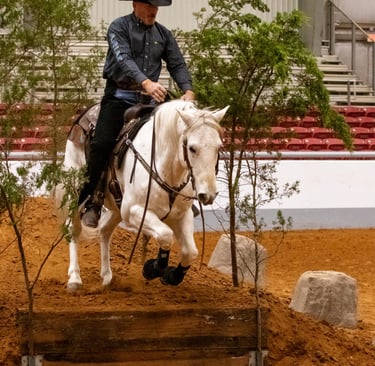
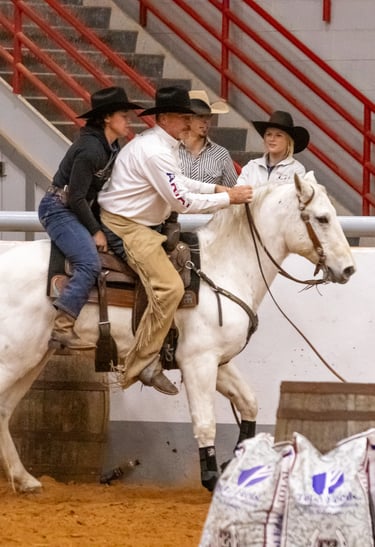

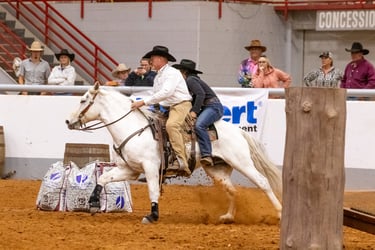

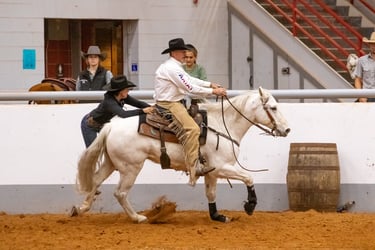



Trials and Triumphs at the World Finals
As a first-timer at the World Finals, I definitely felt like a small fish in a big pond. The caliber of riders and horses there was beyond anything I had seen at local shows. These folks were good. Many had spent all year training and competing to qualify for this event, and it showed. Some riders guided their mounts through the course with the precision of a dance – flying lead changes, sliding stops, fearless approaches to every obstacle. In between my own runs, I became a fan in the stands, cheering and learning. I watched a 83-year-old Ride Smart rider, and a 10-year-old Young Gun zip through a course fearless and flawless. Talk about inspiring! It was clear that Rocky and I had a lot to learn, but we were in the best possible place to learn it.
Our week of competition had its ups and downs – literally. On Day One, during our very first run, we hit a slick spot at a gallop heading into the merry-go-round obstacle. Rocky’s feet slipped right out from under him on a tight turn, and before I knew it, BOOM! we both crashed to the ground. It was one of those slow-motion moments where you think, “This is not how I pictured this going.” For a split second I was worried – mostly about my horse. But Rocky, being the solid and trusting partner he is, just laid there watching me and I am sure thinking "not sure why we are down here". I took a deep breath, checked that he was okay and that I was (more or less) okay, and then… we got back on. The crowd actually cheered when they saw us remount and continue the course. Adrenaline surging, we tackled the remaining obstacles even better than we had in practice. To my astonishment, we finished that course and still scored well enough to place 6th in our division for that round! I think coming back from a spill and not giving up earned us some respect from the judges and fellow competitors. It sure taught me something about perseverance.
After that tumble, I won’t lie – I was rattled. I’m naturally more of a “slow and steady” kind of rider, and the fast and furious pace of EXCA was far outside my comfort zone. But this event was all about pushing beyond comfort. So I reminded myself that we were here to learn and have fun, and I owed it to Rocky to ride with confidence. Each day brought a new course and another chance for us to improve. By our third or fourth run, I could feel a change. Instead of nerves, I felt an excited focus. Rocky seemed to pick up on it too. He started approaching obstacles with ears up, almost as if he was enjoying the game. We got braver with speed when the course had a free-running stretch – galloping full throttle then coming down smoothly for the next task. We improved our rhythm opening gates and honed our side-pass over logs to be cleaner. Mistakes? Oh, we still made a few (damn maypole barrel that we knocked over!). But with each run I learned from the last.
By the last day of the finals, which for us was Run #7, I finally felt like we hit our stride. Who would’ve thought by the end of the week I’d be craving the adrenaline rush? The guy who likes to mosey on quiet trails was now hooting and hollering with pure joy as we raced through the final course. And when we cleared that final obstacle and dashed across the finish line on our last run, I was grinning from ear to ear. We didn’t win any big titles – that honor went to the truly phenomenal riders in the top spots – but in my book, Rocky and I won something just as valuable: confidence in ourselves and an unbreakable bond from having tackled this wild adventure together.
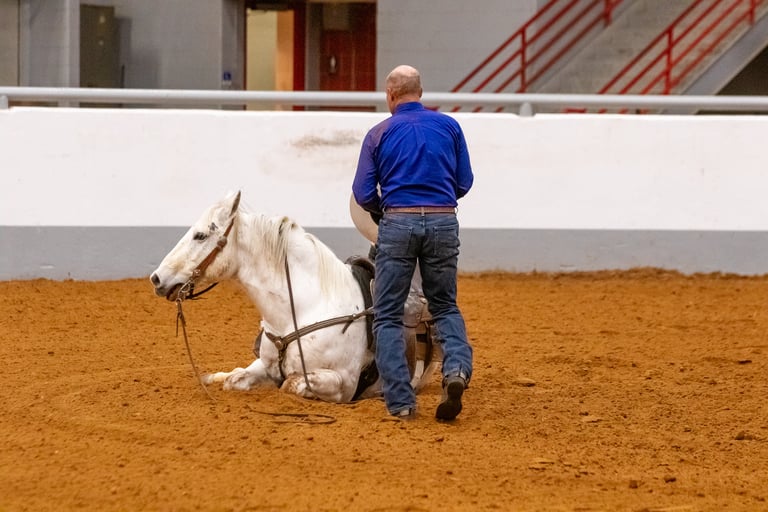


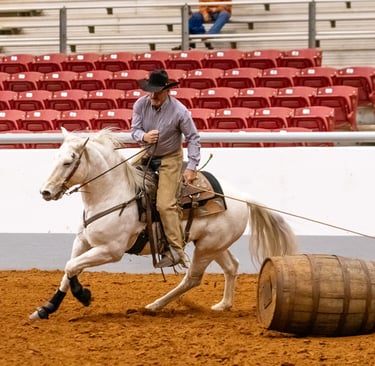

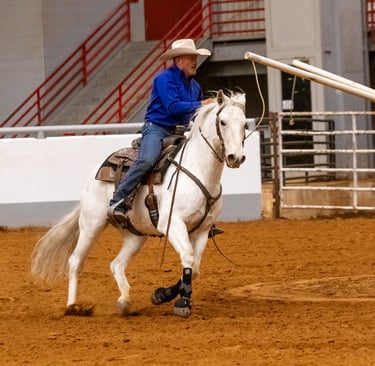
Lessons Learned and Final Reflections
Walking out of the arena after our last ride, I felt a swell of pride (and okay, a bit of relief!) for having come this far. This Extreme Cowboy Racing adventure turned out to be one of the funniest, craziest, and most rewarding experiences I’ve ever had with Rocky. It wasn’t just about ribbons or placements – it was about pushing myself beyond the usual, learning to trust my horse on a deeper level, and discovering a whole community of amazing people in the process. I learned that Rocky is even more of a superstar than I gave him credit for; he tackled everything I pointed him at, with heart and try. I learned that sometimes you have to ride faster than you’re comfortable, and then ride a little faster still, to find out what you and your horse are capable of. And I learned that hitting the dirt is not the end of the world – you dust off, get back in the saddle, and finish what you started (preferably with a smile and maybe a whoop for the crowd).
As I pack up our gear and prepare to head home, I’m not entirely sure where we’ll go next with this sport. Will Rocky and I become regulars on the EXCA circuit, chasing points and titles? Or will this remain a one-of-a-kind memory, a glorious check off the bucket list? Only time will tell. What I do know is that we caught the bug – that addictive thrill of Extreme Cowboy Racing – and it’s hard to imagine this being the end. Even if we slow things down and go back to trail rides for a while, I have a feeling we’ll be building a little obstacle course at home and reenacting some of our favorite challenges (on a much smaller scale, of course!).
In the end, I’m coming away with so much more than a 5th-place ribbon. I have a heart full of memories – of Rocky’s brave ears forward at a daunting obstacle, of friendly competitors cheering us on, of the sound of the buzzer and the rush of crossing the finish line. If you ever get a chance to try an Extreme Cowboy Race, I’d wholeheartedly encourage it. It’s not just a race; it’s a journey that will test you, teach you, and leave you with stories to tell for a lifetime. As for Rocky and me, this adventure has only strengthened our partnership. We came, we stumbled, we conquered our fears, and we had an absolute blast doing it. And in my book, that makes us winners.
Takeaways: Stepping out of your comfort zone can lead to incredible growth for both horse and rider. Extreme Cowboy Racing showed us that speed and good horsemanship go hand-in-hand – you can’t have success without both. Most importantly, we learned that trust is everything. When you trust your horse and your horse trusts you, even the wildest obstacle course in the world can become an unforgettable ride.
